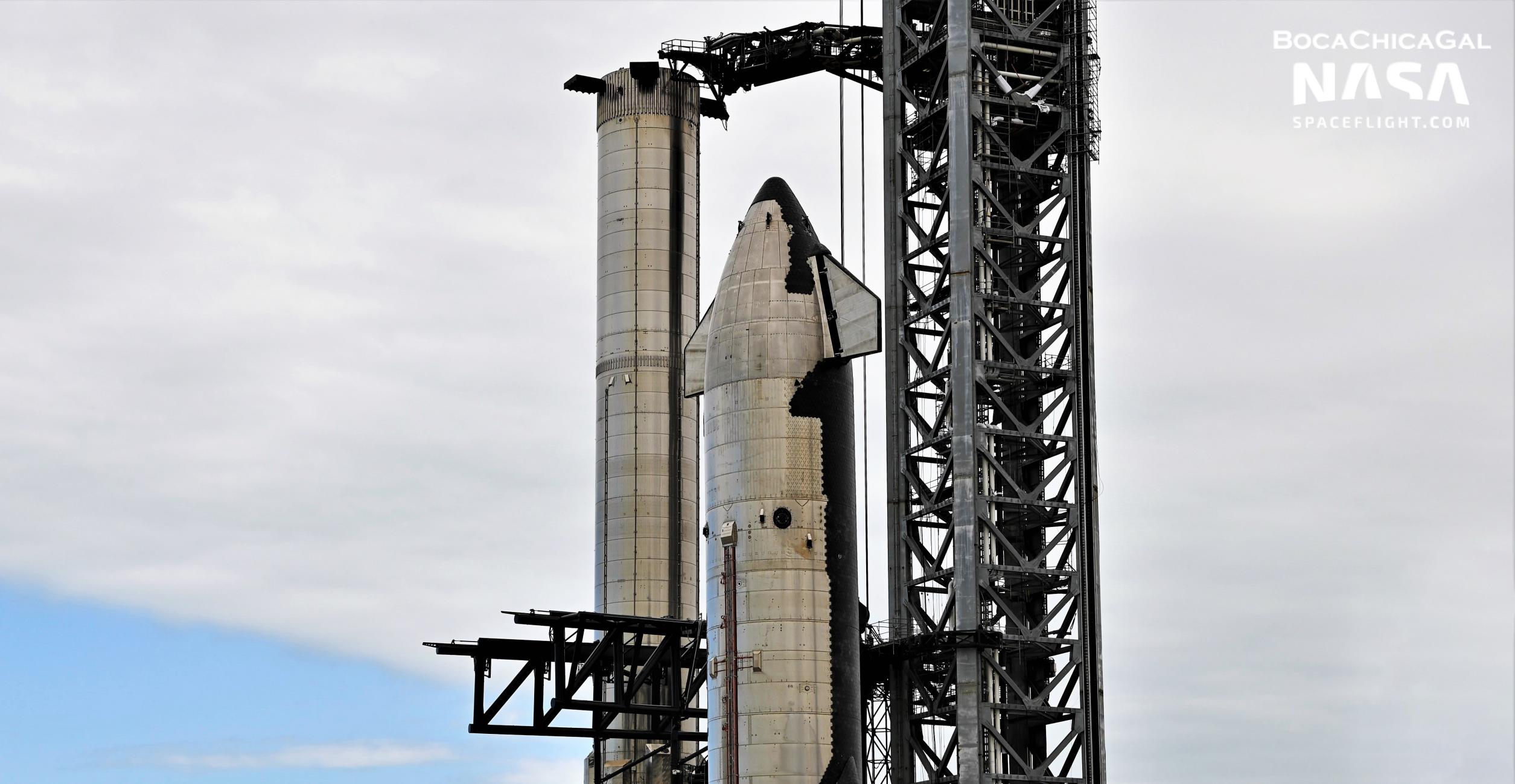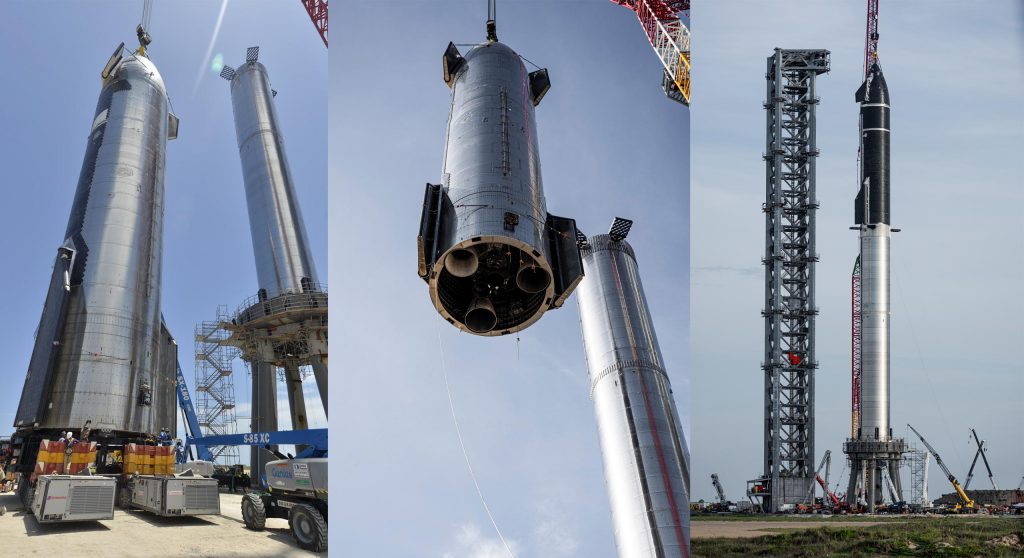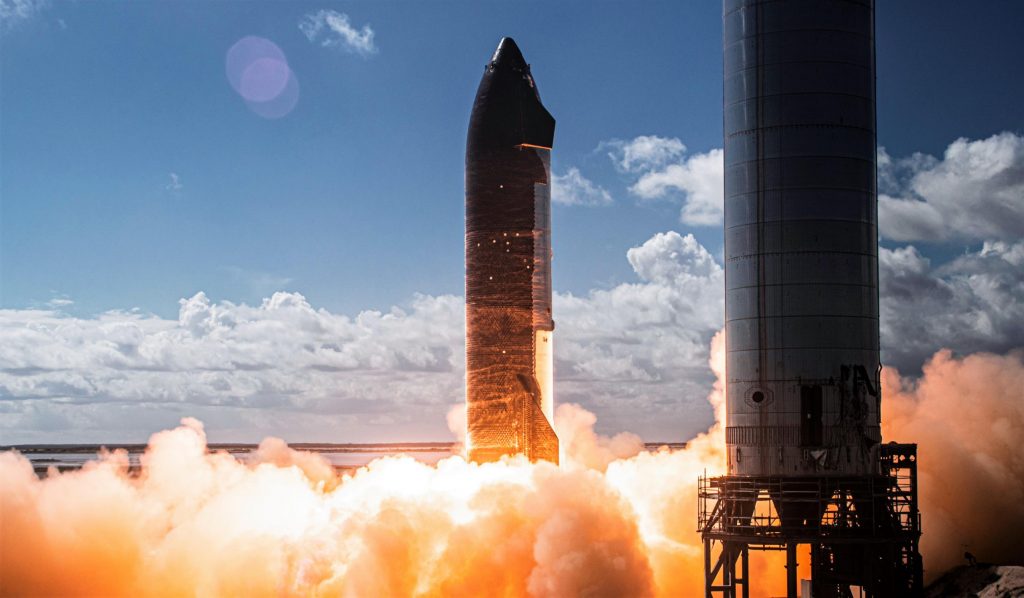

News
SpaceX preparing for third Starship ‘full stack’
SpaceX appears to be preparing Starship 20 and Super Heavy Booster 4 for their third ‘full stack’ demonstration after two seemingly successful tests in August 2021 and February 2022.
The first, completed in early August 2021, was mostly for show and saw SpaceX stack the unfinished prototypes with a giant crane – fighting the coastal winds throughout. After just a few hours stacked, Ship 20 was removed and returned to Starbase, where workers spent several more weeks (mostly) finishing the prototype. Booster 4 followed suit several weeks later and ultimately took another three months of work to reach some level of test readiness.
After Ship 20 and Booster 4 completed a series of tests in the last few months of 2021 and early 2022, the two were re-stacked in mid-February – once again for show. This time, the stacked Starship served as a backdrop for SpaceX CEO Elon Musk’s first official Starship presentation in more than two years. However, despite the fact that neither prototype was actually tested during the second stack, SpaceX did use the opportunity to partially debut Starbase’s ‘orbital launch integration tower’ and used that towers trio of giant arms to lift, stack, and stabilize Starship S20 on top of Super Heavy B4.

Ship 20 was ‘destacked’ with the tower’s arms just a few days after Musk’s event – an undeniably rapid and impressive achievement for the first real use of the ‘chopstick’ arms but still far from demonstrating that Ship 20, Booster 4, or the orbital launch site (OLS) are ready for orbital test flights. Since then, however, Starbase’s launch facilities have admittedly been almost as busy as they’ve ever been with Starship and Super Heavy cryoproof tests.
Ship 20 completed its first basic OLS cryogenic proof test or ‘cryoproof’ just two days after it was destacked. Additional Starship S20 cryoproofs followed on February 17th (the day after), February 22nd, and March 3rd. Super Heavy B4 completed its own cryoproofs on February 18th and March 1st, the latter of which may have actually been the fullest a Starship booster has ever been filled. All told, SpaceX completed no less than six major B4/S20 cryoproof tests in 15 days.
Crucially, all six cryoproofs were performed with Starbase’s nascent orbital tank farm, thoroughly testing its storage and distribution capabilities. Additionally, because SpaceX began liquid methane deliveries on February 13th, some of those tests – particularly with Ship 20 – may have even been proper wet dress rehearsals, meaning that SpaceX may have filled the rocket(s) with liquid methane (LCH4) and liquid oxygen (LOx) propellant to replicate preparations for a real launch.
At a minimum, Super Heavy Booster 4’s oxidizer tank was fully filled with liquid oxygen – and possibly pressurized with hot gaseous oxygen – during its March 1st cryoproof, while its fuel tank was filled about two-thirds of the way either with liquid nitrogen (LN2) or methane. Prior to its February and March tests, Booster 4 had already completed three cryoproofs – some also using LOx – in December 2021. Ship 20 had completed a cryoproof and four static fire tests.

All told, short of finally performing a full Super Heavy wet dress rehearsal and static fire at the orbital launch site, it’s not all that clear what more SpaceX can derive from additional individual cryoproof testing of Ship 20 or Booster 4. Several things do still need to be demonstrated, however. First, the OLS launch tower has yet to use its arms to remotely install a Super Heavy on the orbital launch mount. More importantly, SpaceX has yet to use the launch tower and its swinging ship umbilical arm to cryoproof or fuel a Starship while stacked on top of a Super Heavy. Finally, SpaceX has also yet to simultaneously perform a cryoproof or wet dress rehearsal test of a stacked Starship and Super Heavy, which will be necessary for orbital test flights.
One or several of those to-be-completed tests may be why SpaceX appears to have begun preparing to install Ship 20 on top of Booster 4 for the third time. On March 14th, Starship S20 was moved towards the launch tower and on March 15th, the ship was slotted between its ‘chopstick’ arms. Based on stack #2, the ship could be lifted at any point – day or night – and installed on top of Super Heavy in a matter of hours.

Elon Musk
Elon Musk and Tesla AI Director share insights after empty driver seat Robotaxi rides
The executives’ unoccupied tests hint at the rapid progress of Tesla’s unsupervised Robotaxi efforts.

Tesla CEO Elon Musk and AI Director Ashok Elluswamy celebrated Christmas Eve by sharing personal experiences with Robotaxi vehicles that had no safety monitor or occupant in the driver’s seat. Musk described the system’s “perfect driving” around Austin, while Elluswamy posted video from the back seat, calling it “an amazing experience.”
The executives’ unoccupied tests hint at the rapid progress of Tesla’s unsupervised Robotaxi efforts.
Elon and Ashok’s firsthand Robotaxi insights
Prior to Musk and the Tesla AI Director’s posts, sightings of unmanned Teslas navigating public roads were widely shared on social media. One such vehicle was spotted in Austin, Texas, which Elon Musk acknowleged by stating that “Testing is underway with no occupants in the car.”
Based on his Christmas Eve post, Musk seemed to have tested an unmanned Tesla himself. “A Tesla with no safety monitor in the car and me sitting in the passenger seat took me all around Austin on Sunday with perfect driving,” Musk wrote in his post.
Elluswamy responded with a 2-minute video showing himself in the rear of an unmanned Tesla. The video featured the vehicle’s empty front seats, as well as its smooth handling through real-world traffic. He captioned his video with the words, “It’s an amazing experience!”
Towards Unsupervised operations
During an xAI Hackathon earlier this month, Elon Musk mentioned that Tesla owed be removing Safety Monitors from its Robotaxis in Austin in just three weeks. “Unsupervised is pretty much solved at this point. So there will be Tesla Robotaxis operating in Austin with no one in them. Not even anyone in the passenger seat in about three weeks,” he said. Musk echoed similar estimates at the 2025 Annual Shareholder Meeting and the Q3 2025 earnings call.
Considering the insights that were posted Musk and Elluswamy, it does appear that Tesla is working hard towards operating its Robotaxis with no safety monitors. This is quite impressive considering that the service was launched just earlier this year.
Elon Musk
Starlink passes 9 million active customers just weeks after hitting 8 million
The milestone highlights the accelerating growth of Starlink, which has now been adding over 20,000 new users per day.

SpaceX’s Starlink satellite internet service has continued its rapid global expansion, surpassing 9 million active customers just weeks after crossing the 8 million mark.
The milestone highlights the accelerating growth of Starlink, which has now been adding over 20,000 new users per day.
9 million customers
In a post on X, SpaceX stated that Starlink now serves over 9 million active users across 155 countries, territories, and markets. The company reached 8 million customers in early November, meaning it added roughly 1 million subscribers in under seven weeks, or about 21,275 new users on average per day.
“Starlink is connecting more than 9M active customers with high-speed internet across 155 countries, territories, and many other markets,” Starlink wrote in a post on its official X account. SpaceX President Gwynne Shotwell also celebrated the milestone on X. “A huge thank you to all of our customers and congrats to the Starlink team for such an incredible product,” she wrote.
That growth rate reflects both rising demand for broadband in underserved regions and Starlink’s expanding satellite constellation, which now includes more than 9,000 low-Earth-orbit satellites designed to deliver high-speed, low-latency internet worldwide.
Starlink’s momentum
Starlink’s momentum has been building up. SpaceX reported 4.6 million Starlink customers in December 2024, followed by 7 million by August 2025, and 8 million customers in November. Independent data also suggests Starlink usage is rising sharply, with Cloudflare reporting that global web traffic from Starlink users more than doubled in 2025, as noted in an Insider report.
Starlink’s momentum is increasingly tied to SpaceX’s broader financial outlook. Elon Musk has said the satellite network is “by far” the company’s largest revenue driver, and reports suggest SpaceX may be positioning itself for an initial public offering as soon as next year, with valuations estimated as high as $1.5 trillion. Musk has also suggested in the past that Starlink could have its own IPO in the future.
News
NVIDIA Director of Robotics: Tesla FSD v14 is the first AI to pass the “Physical Turing Test”
After testing FSD v14, Fan stated that his experience with FSD felt magical at first, but it soon started to feel like a routine.

NVIDIA Director of Robotics Jim Fan has praised Tesla’s Full Self-Driving (Supervised) v14 as the first AI to pass what he described as a “Physical Turing Test.”
After testing FSD v14, Fan stated that his experience with FSD felt magical at first, but it soon started to feel like a routine. And just like smartphones today, removing it now would “actively hurt.”
Jim Fan’s hands-on FSD v14 impressions
Fan, a leading researcher in embodied AI who is currently solving Physical AI at NVIDIA and spearheading the company’s Project GR00T initiative, noted that he actually was late to the Tesla game. He was, however, one of the first to try out FSD v14.
“I was very late to own a Tesla but among the earliest to try out FSD v14. It’s perhaps the first time I experience an AI that passes the Physical Turing Test: after a long day at work, you press a button, lay back, and couldn’t tell if a neural net or a human drove you home,” Fan wrote in a post on X.
Fan added: “Despite knowing exactly how robot learning works, I still find it magical watching the steering wheel turn by itself. First it feels surreal, next it becomes routine. Then, like the smartphone, taking it away actively hurts. This is how humanity gets rewired and glued to god-like technologies.”
The Physical Turing Test
The original Turing Test was conceived by Alan Turing in 1950, and it was aimed at determining if a machine could exhibit behavior that is equivalent to or indistinguishable from a human. By focusing on text-based conversations, the original Turing Test set a high bar for natural language processing and machine learning.
This test has been passed by today’s large language models. However, the capability to converse in a humanlike manner is a completely different challenge from performing real-world problem-solving or physical interactions. Thus, Fan introduced the Physical Turing Test, which challenges AI systems to demonstrate intelligence through physical actions.
Based on Fan’s comments, Tesla has demonstrated these intelligent physical actions with FSD v14. Elon Musk agreed with the NVIDIA executive, stating in a post on X that with FSD v14, “you can sense the sentience maturing.” Musk also praised Tesla AI, calling it the best “real-world AI” today.








